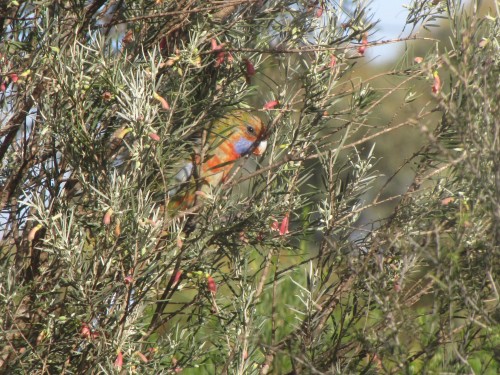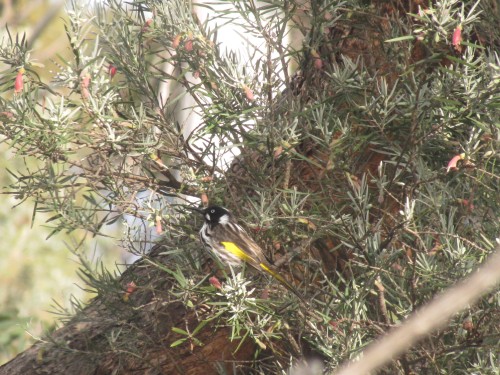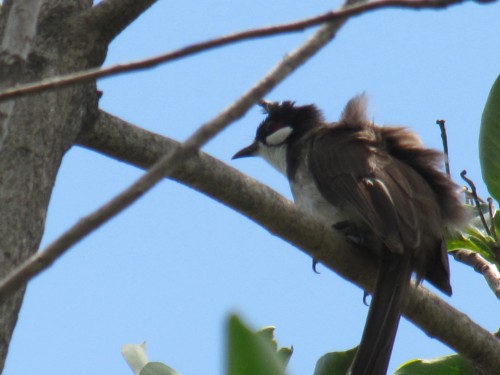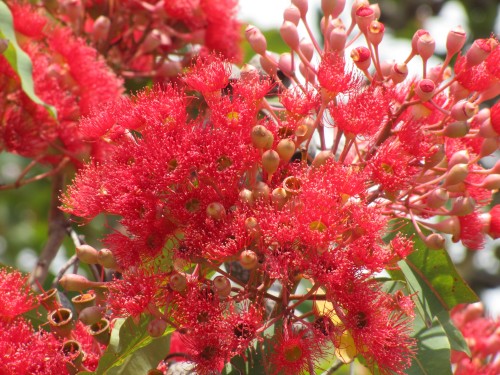Feeding Adelaide Rosellas
Last weekend we were having breakfast in our sun-room when four Adelaide Rosellas flew into one of the bushes in our garden, an Eremophila youngii (see photo above). I had the camera ready for many minutes but they would not come out into full sunlight and the above photo is the best I captured on this occasion. Just one bird is seen peeking out to see what was happening around it. The others were hidden in the foliage, busy feeding on the nectar in the flowers.
The Adelaide Rosella is now a frequent visitor to our garden. It is a race of the widespread Crimson Rosella and confined to the Adelaide region, Mt Lofty Ranges and mid-north of South Australia. Its occurrence here in Murray Bridge is a relatively recent extension of that range.
Parrots occurring in our garden in Murray Bridge include:
- Adelaide Rosella (regular visitor, possibly breeding)
- Crimson Rosella (occasional)
- Eastern Rosella (regular)
- Mallee Ringneck (resident breeding)
- Galah (resident breeding)
- Rainbow Lorikeet (regular)
- Purple-crowned Lorikeet (regular)
- Musk Lorikeet (occasional)
- Budgerigar (rare)
- Sulphur-crested Cockatoo (rare)
- Little Corella (occasional)
- Yellow-tailed Black-cockatoo (once only)
- Cockatiel (occasional)
- Red-rumped Parrot (occasional)
Over the years we have lived here we have planted many native Australian plants, not only for their attractiveness when they flower, but also to attract our native wildlife, especially the birds. We have quite a few eremophilas, grevilleas and correas as well as many others. The particular bush shown in the photo has flowers on it for much of the year so the rosellas and honeyeaters head for it on a daily basis. Below is another photo of the same bush, this time with a New Holland Honeyeater having a feed.
Further reading:
- Get out of my patch
- Red wattlebird in Eremophila bush
- Mallee Native Plants Nursery – my wife’s site about Australian plants
A visit to the Australian Botanic Gardens part 2
On my recent visit to the Australian Botanic Garden Mt Annan in the south east of greater Sydney, I was immediately drawn to the wet fern gully just south of the Visitor Centre. One of my favourite birds, the Rufous Fantail, had been sighted there only a few days before. I hadn’t seen this species for over a decade, mainly because I don’t go birding in the right places, or at the right time. One can only hope.
I could hear birds all around. Most were being very noisy – but also very secretive. Some calls I was not familiar with, being from a different part of Australia. Eventually a solitary Red-whiskered Bulbul showed itself briefly. Not in ideal light conditions, nor close enough for a good photo, but long enough for several shots. The one above is the best of them. Next time, perhaps. Oh, the joys of bird photography. (You can see a better photo I took some time ago here.)
Still, I had much more luck with the flowering Eucalypt tree shown below. At least flowers tend to be in sun – and they generally stand still, though I have known a few flowers which were hard to shoot because of the wild wind.
More tomorrow.
Beautiful Superb Fairy-wren
This morning I was sitting in our sun room doing some reading. I looked up and saw the male Superb Fairy-wren shown above and grabbed the camera before it flitted off into the vegetation. I had to take about four steps to get the camera and I was delighted that the bird stayed in position until I could focus and shoot. I only had time to manage one photo, but I’m quite happy with it. This species – like all of our wrens – are very flighty birds, never staying in one spot for more than a second or two – at best.
This individual, along with two uncoloured birds, has been resident in our garden now for over a year. This is delightful because, until a year ago, we had only recorded this species on a handful of occasions over the previous 28 years, despite them being common in our region. My next challenge is to get a shot of a female, preferably alongside the male.
The flowers belong to a Melaleuca lanceolata bush in our garden. It’s a common plant species in our area. For more about Australian native plants, have a look at my wife’s site, Mallee Native Plants.
My readers might like to also see photos of the Red-backed Fairy-wren over at Snail’s Eye View. This is one species I still have the delight to see in the wild.
Some of the photos shown here on Trevor’s Birding can now be purchased on tee shirts, coffee mugs, stationary and a large range of other items. Go to Trevor’s Photos site here.
Pigeons by the dozens (almost)
I had a doctor’s appointment this morning. Nothing major; just a check up.
As I was driving out of the driveway I noticed that one of the bushes in our garden had suddenly “sprouted” some extra colour. (Confession: the bush is actually dead – I just haven’t got around to removing it yet, or replacing it with something living.)
Eleven crested pigeons were sitting there all fluffed up against the chilly morning and enjoying the early morning sunshine. It wasn’t a very big bush, so it looked really great.
Crested Pigeons are very common in our area. I frequently see loose flocks of a dozen or more – sometimes as many as 30 or 40 – perched on power lines or fences. Once I even counted about 60 all in close proximity to one another. It was quite a sight.
Parrots eating our flowers

Mallee Ringneck parrot
Mallee Ringneck parrots are common around my home town of Murray Bridge in South Australia. Almost everyday we have a small number visiting our garden. In fact, I would regard them as a resident species because there are very few days when we don’t see or hear them.
They have taken a liking to the beautiful Eremophila plant shown in the photos on this post. The nectar in the flowers must be delightful to them. Of course, after they have visited each bush there is a carpet of petals on the ground under the bush.

Mallee Ringneck parrot

Mallee Ringneck parrot






